International Journal of Image, Graphics and Signal Processing @ijigsp
Статьи журнала - International Journal of Image, Graphics and Signal Processing
Все статьи: 1157
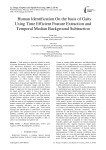
Статья научная
Gait analysis is basically referred to study of human locomotion. From the surveillance point of view behavioral biometrics and recognition at a distance are becoming more popular in researchers rather than interactive and Physiological biometrics. In this paper, a time efficient Human gait identification system is proposed. Initially Human silhouettes are extracted by using temporal median background subtraction on video frames, which successfully removes shadows and models even complex background, proposed gait algorithm extracts contours from foreground silhouettes images and then three bounding boxes are drawn around contoured human image 1) upper part for arms movement 2) middle part for thigh and knee angles 3) Lower part for legs movement, knee and ankle angles. Gait cycles are extracted to find gait period and to take final decision for gait features selection, which is used for training. Thigh, Knee, Ankle angles and bounding boxes' widths are used as gait signatures but middle portion of human contains less variations of width in gait cycle hence computing efficiency can be achieved by ignoring width factor of middle part. SVM based training and identification is performed on extracted gait features. The proposed system is assessed using publicly available gait datasets and some indoor experimental videos created for this research work. The results reveal that the proposed algorithm is able to achieve an outstanding recognition rate.
Бесплатно
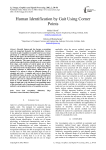
Human Identification by Gait Using Corner Points
Статья научная
Recently human gait has become a promising and very important biometric for identification. Current research on gait recognition is usually based on an average gait image or a silhouette sequence, or a motion structure model. In this paper, the information about gait is obtained from the disparity on time and space of the different parts of the silhouette. This paper proposes a gait recognition method using edge detection, identification of corner points from edges, and selection of control points out of those corner points. Here, the images of moving human figures are subtracted from background by simple background modeling technique to obtain binary silhouettes. A gait signature of a person is taken as silhouette images of a complete gait cycle. A complete gait cycle is then divided into different frames in such a way that the information of the person’s gait style can be represented fully. One given unknown gait cycle is compared with stored gait cycles in terms of a cyclic distances between control points of an image of input gait cycle with that of corresponding image of the stored gait cycle. Experimental results show that our method is encouraging in terms of recognition accuracy.
Бесплатно
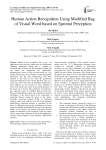
Human action recognition using modified bag of visual word based on spectral perception
Статья научная
Human action recognition has a very vast application such as security, patient care, etc. Background cluttering, appearance change due to variation in viewpoint and occlusion are the prominent hurdles that can reduce the recognition rate significantly. Methodologies based on Bag-of-visual-words are very popular because they do not require accurate background subtraction. But the main disadvantage with these methods is that they do not retain the geometrical structural information of the clusters that they form. As a result, they show intra-class mismatching. Furthermore, these methods are very sensitive to noise. Addition of noise in the cluster also results in the misclassification of the action. To overcome these problems we proposed a new approach based on modified Bag-of-visual-word. Proposed methodology retains the geometrical structural information of the cluster based on the calculation of contextual distance among the points of the cluster. Normally contextual distance based on Euclidean measure cannot deal with the noise but in the proposed methodology contextual distance is calculated on the basis of a difference between the contributions of cluster points to maintain its geometrical structure. Later directed graphs of all clusters are formed and these directed graphs are described by the Laplacian. Then the feature vectors representing Laplacian are fed to the Radial Basis Function based Support Vector Machine (RBF-SVM) classifier.
Бесплатно
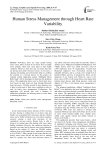
Human stress management through heart rate variability
Статья научная
Nowadays, there are many people having stress issues. Most of them do not know how to handle stress properly which may cause harm to their health condition. Moreover, they also may not notice that they are having stress until it become worsen. As we know, a calming surrounding and environment helps in soothing the emotion of a stressed person. In this project, an Android mobile application named “Intelligent Stress Relief App” will be developed to minimize the problems above. This application allows user to check their stress level based on their heart rate data through Bluetooth heart rate sensor. With the records of stress patterns, user is able to keep track of their stress condition in order to seek for better stress management. Furthermore, this application will provide user with a database of meditation techniques and relaxing music to assist them in releasing their stress.
Бесплатно
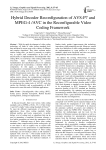
Статья научная
With the rapid development of video coding technology, all kinds of video coding standards have been advanced in recent years with a variety of different and complex algorithms. They share common and/or similar coding tools, yet there is currently no explicit way to exploit such commonalities at the level of specifications or implementations. Reconfigurable video coding (RVC) is to develop a video coding standard that overcomes many shortcomings of current standardization and specification process by updating and progressively incrementing a modular library of components. In this paper, a hybrid decoder reconfiguration is instantiated in the RVC framework by grouping the coding tools from AVS-P7 and MPEG-4/AVC. Experimental results show that compared with MPEG-4/AVC baseline profile, the reconfigurable coding system reduces the computational complexity and guarantees the coding performance at low bit rate. Moreover, it enriches the RVC video tool library (VTL) by introducing the coding tools of AVS-P7, and also verifies the flexibility and re-configurability of RVC framework to meet the needs of different applications.
Бесплатно
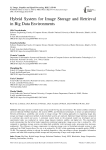
Hybrid System for Image Storage and Retrieval in Big Data Environments
Статья научная
This paper presents a hybrid image storage model for big data environments. The model combines relational and non-relational (NoSQL) databases, file systems (IPFS), and blockchain technologies to ensure an optimal balance between performance, scalability, and security in image storage. The existing approaches to organising image data storage and image compression methods in decentralised systems are analysed. Optimised image indexing is proposed to accelerate data search and access. A prototype system based on the proposed model was developed, and an experimental study was conducted on various image datasets (medical, satellite, and digital art). The experimental results demonstrate that the hybrid model outperforms traditional approaches: image access time is reduced by ~30% compared to standalone storage systems, providing high scalability (with increased nodes, processing time decreases nonlinearly). The efficiency of image compression in reducing storage costs in blockchain-oriented systems is also confirmed: the WebP format allows file size to be reduced by 40–60% while maintaining acceptable quality (PSNR > 30 dB). The proposed solution is relevant for medical diagnostics, video surveillance systems, geographic information systems, and other fields requiring reliable storage and fast processing of large-scale image datasets.
Бесплатно
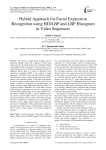
Hybrid approach for facial expression recognition using HJDLBP and LBP histogram in video sequences
Статья научная
Any kind of compassionate thoughts can't be expressed through words, but it appears on their facial expression. So, the facial expression reveals the emotions of individuals. The recognition of such emotions can be understood correctly or sometimes ambiguously from the opponent. Hence, there is a scope for automatic facial expression recognition (FER) in the context of image processing. The FER system has three different phases: face detection, feature extraction and expression classifi-cation. In face detection phase, Viola Jones face detector is used to crop the original image such that only the face region is retained by removing the unwanted region. In feature extraction stage, High-order Joint Derivative Lo-cal Binary Pattern (HJDLBP) and Local Binary Pattern (LBP) histogram algorithms are used for extracting fea-tures from the cropped image. In last stage, Support Vec-tor machine (SVM) classifier is used in finding the precise facial expression.CK+ dataset has been used for training and testing, which consist of 442 image samples. We have considered six different universal possible ex-pressions such as, happy, anger, disgust, fear, surprised, and sad for identification. The experimental results indi-cate that the overall accuracy of the proposed system was 74.8%, which is high compare to the results available in literature.
Бесплатно
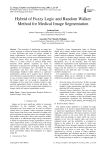
Hybrid of Fuzzy Logic and Random Walker Method for Medical Image Segmentation
Статья научная
The procedure of partitioning an image into various segments to reform an image into somewhat that is more significant and easier to analyze, defined as image segmentation. In real world applications, noisy images exits and there could be some measurement errors too. These factors affect the quality of segmentation, which is of major concern in medical fields where decisions about patients’ treatment are based on information extracted from radiological images. Several algorithms and techniques have developed for image segmentation and have their own advantages and disadvantages. Random walker method is a supervised segmentation method and it requires that it should be more efficient in producing effective segmentation results in case of medical images which are complex images. In the present paper, we are going to incorporate the advantages of fuzzy logic with a random walker to make resulting segmentation better in texture and quality. For this, we will use fuzzy rules to approximate boundaries in images which will improve segmentation results.
Бесплатно
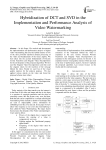
Hybridization of DCT and SVD in the Implementation and Performance Analysis of Video Watermarking
Статья научная
In this Paper, We worked and documented the implementation and performance analysis of digital video watermarking that uses the hybrid features of two of the most powerful transform domain processing of the video and fundamentals of the linear algebra. We have taken into the account fundamentals of Discrete Cosine Transform and Singular Value Decomposition for the development of the proposed algorithm. We first used the Singular Value Decomposition and then used the singular values for the insertion of the message behind the video. Finally we used two of the visual quality matrices for the analysis purpose. We also applied various attacks on the video and found the proposed scheme more robust.
Бесплатно
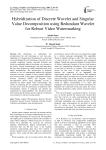
Статья научная
The distribution of multimedia has revolutionized the web technology at very fast pace. Duplication of computerized information are created and conveyed through the web technology. Unlawful acts, for example, tampering, forging, copyright isolations and frauds on multimedia data are becoming very common in the society. Digital watermarking is one such innovation that has been produced to shield multimedia data from illegal manipulations. The advancement of technical solutions in view of watermarking method for copyright assurance has been a subject of active research amid the most recent decade. In this paper, hybridization Discrete Wavelet Transform (DWT) and Singular Value Decomposition (SVD) using redundant wavelet is proposed for robust digital video watermarking. The results of combining the two transform using redundant wavelets shows that the performance of proposed video watermarking scheme is enhanced and satisfies the requirement of imperceptibility. The presented results also showed that the scheme has the capacity to withstand an assortment of video processing attacks.
Бесплатно
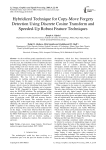
Статья научная
As the world has greatly experienced a serious advancement in the area of technological advancement over the years, the availability of lots of sophisticated and powerful image editing tools has been on the rise. These image editing tools have become easily available on the internet, which has made people who are a novice in the field of image editing, to be capable of tampering with an image easily without leaving any visible clue or trace behind, which has led to increase in digital images losing authenticity. This has led to developing various techniques for tackling authenticity and integrity of forged images. In this paper, a robust and enhanced algorithm is been developed in detecting copy-move forgery, which is done by hybridizing block-based DCT (Discrete Cosine Transform) technique and a keypoint-based SURF (Speeded-Up Robust Feature)technique using the MATLAB platform. The performance of the above technique has been compared with DCT and SURF techniques as well as other hybridized techniques in terms of precision, recall, FPR and accuracy metrics using MICC-F220 dataset. This technique works by applying DCT to the forged image, with the main goal of enhancing the detection rate of such image and then SURF is applied to the resulting image with the main goal of detecting those areas that are been tampered with on the image. It has been observed that this paper’s technique named HDS has an effective detection rate on the MICC-F220 dataset with multiple cloning attacks and other various attacks such as rotation, scaling, a combination of scaling plus rotation, blur, compression, and noise.
Бесплатно
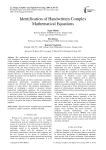
Identification of handwritten complex mathematical equations
Статья научная
The mathematical notation is well known and used throughout the world. Humanity has evolved from simple methods to represent accounts to the current formal notation capable of modeling complex problems. In addition, mathematical equations are a universal language in the scientific world, and many resources such as science and engineering technology, medical field also not an exception containing mathematics have been created during the last decades. However, to efficiently access all that information, scientific documents must be digitized or produced directly in electronic formats. Although most people are able to understand and produce mathematical information, introducing mathematical equations into electronic devices requires learning special notations or using editors. The proposed methodology is focused on developing a method to recognize intricate handwritten mathematical equations. For pre-processing, Gray conversion and Weiner filtering are used. Segmentation is performed using the morphological operations, which increase the efficiency of the subsequent image of equation. Finally Neural Network based template matching technique is used to recognize the image of handwritten mathematical equation.
Бесплатно
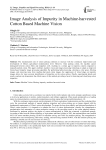
Image Analysis of Impurity in Machine-harvested Cotton Based Machine Vision
Статья научная
The mechanization rate of cotton picking continues to increase with the continuous improvement and development of China's agricultural modernization level. However, when picking cotton, the machine cannot distinguish between cotton fibers and impurities well, resulting in a certain gap in impurity content compared to manually picked cotton. This paper combines machine vision and image processing technology to adopt an improved Canny-based impurity image processing algorithm. By performing light processing, selecting a color space, filtering images, and removing noise from machine-harvested cotton images, the suppression of virtual edges on impurity images allows for more accurate identification of impurities on the cotton surface. Finally, experimental details and results conclusively demonstrate the effectiveness of this method, providing a basis for detecting and classifying cotton impurities.
Бесплатно
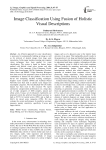
Image Classification Using Fusion of Holistic Visual Descriptions
Статья научная
An efficient approach for scene classification is necessary for automatically labeling an image as well as for retrieval of desired images from large scale repositories. In this paper machine learning and computer vision techniques have been applied for scene classification. The system is based on feature fusion method with holistic visual color, texture and edge descriptors. Color moments, Color Coherence Vector, Color Auto Correlogram, GLCM, Daubechies Wavelets, Gabor filters and MPEG-7 Edge Direction Histogram have been used in the proposed system to find the best combination of features for this problem. Two state-of-the-art soft computing machine learning techniques: Support vector machine (SVM) and Artificial Neural Networks have been used to classify scene images into meaningful categories. The benchmarked Oliva-Torralba dataset has been used in this research. We report satisfactory categorization performances on a large data set of eight categories of 2688 complex, natural and urban scenes. Using a set of exhaustive experiments our proposed system has achieved classification accuracy as high as 92.5% for natural scenes (OT4) and as high as 86.4% for mixed scene categories (OT8). We also evaluate the system performance by predictive accuracy measures namely sensitivity, specificity, F-score and kappa statistic.
Бесплатно
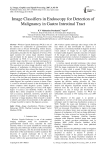
Image Classifiers in Endoscopy for Detection of Malignancy in Gastro Intestinal Tract
Статья научная
Wireless Capsule Endoscopy (WCE) is one of the methods for examination of gastrointestinal (GI) disorders such as obscure GI bleeding, Crohns disease, polyps etc. WCE has been recognized as a less expensive and painless procedure for the diagnosis of GI tract. This paper examines the various image classifiers designed and developed for the purpose of endoscopy focusing specifically on WCE. It is revealed that designing a suitable image classifier is an important prerequisite for accurate and precise diagnosis of malignancy in WCE. The assessment on various image classifiers used for the diagnosis of pathologies in different parts of GI tract shows that classifiers have reduced the diagnosis time for medical experts and also provided reasonably accurate diagnosis of malignancy. However, correlating classifiers and related pathologies is still observed to be challenging. In view of the fact that early detection may decrease the mortality rate significantly, inclination towards computer aided diagnosis are expected to increase in future. There is a need for advanced research in the development of a robust computer aided diagnosis system, capable of diagnosis of various pathologies in GI tract with higher degree of accuracy and reliability. Further, the study depicts that a direct comparison of results of classifier such as accuracy, prediction, sensitivity, specificity and precision to evaluate its performance is challenging due to diversity of image databases. More research is needed to identify and reduce the uncertainties in the application of image classifier to improve the diagnosis accuracy.
Бесплатно
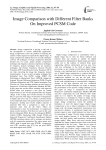
Image Comparison with Different Filter Banks On Improved PCSM Code
Статья научная
Image compression is playing a vital role in the development of various multimedia applications. Image Compression solves the problem of reducing the amount of data required to represent the digital image. In image compression methods there are several techniques evolved. All techniques of image compression basically divided into two parts, spatial domain compression technique and frequency domain compression technique. In frequency domain techniques there are numerous techniques like Fourier Transform, Discrete Wavelet Transform (DWT) and Discrete Cosine Transform (DCT) etc. after converting the image into frequency domain transformation, it uses several encoding technique like Embedded Zero Tree (EZW) coding, SPIHT (Set Partitioning in Hierarchical Tree), ASWDR (Adaptively Scanned Wavelet Difference Reduction) WDR (Wavelet Difference Reduction) and STW (Spatial orientation Tree Wavelet) etc. These encoding schemes are also known as Progressive Coefficients Significance Methods (PCSM). In this paper the wavelet filters combine with improved PCSM codes and proposed a new filter for further improvement. In new wavelet proposed filter has slightly change in the scaling and wavelet function of existing filter. It gives the wide range of selectivity of frequencies in higher and lower side of it. Hence it provides better lower bandwidth range with greater high preservation of frequencies. Scaling and wavelet impulse response of proposed filter then a comparison is made on the proposed work with all the filters. Filters are demonstrated to show the performance of compression using wavelet functions. The filters are used in the work like bi-orthogonal (BIO), Reverse bi-orthogonal (RBIO), Coiflets (COIF), Daubechies (DB), Symlet (SYM) and Improved Progressive Coefficients Significance Method (IPCSM) encoding scheme will be compare and analyze with all compression parameters like mean square error (MSE), peak to signal noise ratio (PSNR), compression ratio (CR), execution time (ET), bits per pixel (BPP), root mean square error (MSE).
Бесплатно
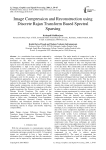
Image Compression and Reconstruction using Discrete Rajan Transform Based Spectral Sparsing
Статья научная
As a contribution from research conducted by many, various image compression techniques have been developed on the basis of transformation or decomposition algorithms. The compressibility of a signal is seen to be affected by the entropy in the signal. Compressibility is high if the energy distribution is concentrated in fewer coefficients. It is reasonable to expect that sparse signals have a highly compressible nature. Thus, sparse representations have potential uses in image compression techniques. There are many techniques used for this purpose. As an alternative to these traditional approaches, the use of Discrete Rajan Transform for sparsification and image compression was explored in this paper. The simulation results show that higher quality compression can be achieved for images using Discrete Rajan Transform in comparison with other popular transforms like Discrete Cosine Transform, and Discrete Wavelet Transform. The results of the experiment were analyzed on the basis of seven quality measurement parameters – Mean Squared Error, Peak Signal to Noise ratio, Normalized Cross-Correlation, Average Difference, Structural Content, Maximum Difference, and Normalized Absolute Error. It was observed that Discrete Rajan Transform is effective in introducing sparsity in images and thereby improving compressibility.
Бесплатно
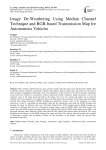
Статья научная
Static weather conditions like fog, haze, and mist in hilly and urban areas cause reduced road visibility. Due to different weather conditions, autonomous vehicles cannot identify objects, traffic signs, and signals. So, this leads to many accidents, endangering living beings’ lives. The significance of this work lies in its aim to develop a model that can provide clear visibility for autonomous vehicles during bad weather conditions. Image restoration is one of the important issues in the image processing field as the images may be of low contrast and quality due to restricted visibility and, the development of a model that reduces the halos and artifacts produced in the image using the Median Channel based Image Restoration (MCIR) technique has significant research value. In this technique, the image restoration is done by calculating the atmospheric light and the transmission map using the MCIR technique and patching the pixels for different patch sizes. The Dark Channel Prior (DCP) method and the MCIR technique are compared for different patch sizes by evaluating the output images using the PSNR, SSIM, and MSE metrics. The results show that MCIR technique provides better Peak Signal-to-Noise Ratio (PSNR), Mean Square Error (MSE), and Structural Similarity Index Measure (SSIM) values than the DCP method with reduced halos and artifacts. This result highlights the effectiveness of the MCIR technique for image restoration. The software model developed can be applied to autonomous vehicles and surveillance cameras for the restoration of the images, which can improve their performance and safety.
Бесплатно
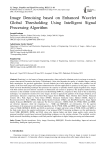
Статья научная
Denoising is a vital aspect of image preprocessing, often explored to eliminate noise in an image to restore its proper characteristic formation and clarity. Unfortunately, noise often degrades the quality of valuable images, making them meaningless for practical applications. Several methods have been deployed to address this problem, but the quality of the recovered images still requires enhancement for efficient applications in practice. In this paper, a wavelet-based universal thresholding technique that possesses the capacity to optimally denoise highly degraded noisy images with both uniform and non-uniform variations in illumination and contrast is proposed. The proposed method, herein referred to as the modified wavelet-based universal thresholding (MWUT), compared to three state-of-the-art denoising techniques, was employed to denoise five noisy images. In order to appraise the qualities of the images obtained, seven performance indicators comprising the Root Mean Square Error (RMSE), Mean Absolute Error (MAE), Structural Content (SC), Peak Signal to Noise Ratio (PSNR), Structural Similarity Index Method (SSIM), Signal-to-Reconstruction-Error Ratio (SRER), Blind Spatial Quality Evaluator (NIQE), and Blind/Referenceless Image Spatial Quality Evaluator (BRISQUE) were employed. The first five indicators – RMSE, MAE, SC, PSNR, SSIM, and SRER- are reference indicators, while the remaining two – NIQE and BRISQUE- are referenceless. For the superior performance of the proposed wavelet threshold algorithm, the SC, PSNR, SSIM, and SRER must be higher, while lower values of NIQE, BRISQUE, RMSE, and MAE are preferred. A higher and better value of PSNR, SSIM, and SRER in the final results shows the superior performance of our proposed MWUT denoising technique over the preliminaries. Lower NIQE, BRISQUE, RMSE, and MAE values also indicate higher and better image quality results using the proposed modified wavelet-based universal thresholding technique over the existing schemes. The modified wavelet-based universal thresholding technique would find practical applications in digital image processing and enhancement.
Бесплатно
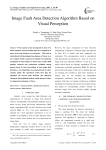
Image Fault Area Detection Algorithm Based on Visual Perception
Статья научная
If the natural scenes decomposed by basic ICA which simulates visual perception then the arrangement in space of its basis functions are in disorder. This result is contradicted with physiological mechanisms of vision. So, a new compute model is proposed to simulate two important mechanisms of vision which are visual cortex receptive field topology construct and synchronous oscillation among neuron group. To solve the problem of train image fault detection, a novel algorithm was proposed based on above compute model. The experiment results show that, the algorithm can increase fault detection rate effectively compared with traditional methods which absence of above two important mechanisms of vision.
Бесплатно

